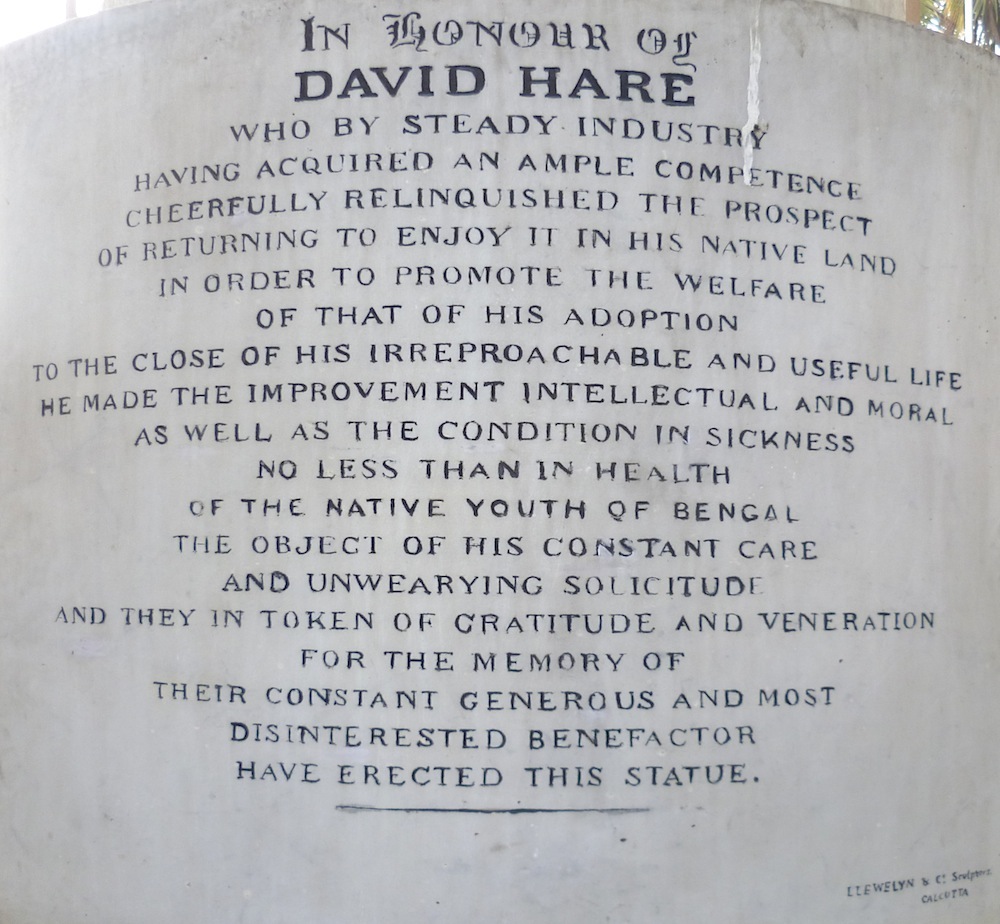

Left: David Hare, from the front. Right: Close-up of face. [Click on these and the following images for larger pictures.]
David Hare (1775-1842) by Edward Hodges Baily (1768-1867), a marble statue of 1838 by the side of the playing-field of Hare School, Kolkata, protected by a tall, corrugated-iron roofed structure. This was listed in the Royal Academy's Sculpture section for the exhibition of 1838 as follows: 1404 Marble statue of the late David Hare, Esq., who, in conjunction with the late Raman Raye [Rammohun Ray] established in Calcutta a college for national education, in which it is to be erected E. H. Baily, R.A." (56). However, the inscription on the base of the stand which supports Hare's books [see close-up here] has: "E. H. BAILY. R.A. SCULP. LONDON 1845. It seems that the statue was only executed after Hare's death.



Left to right: (a) View from the left. (b) Hare School, with the statue at the extreme left. (c) View from the right.
The statue was said to be "a striking and excellent likeness" of its subject (Mittra 101), a Scottish-born watchmaker who had come out to Calcutta in 1800 to follow his trade there, but was inspired” by progressive ideals and become "an ardent educationist and a veteran social reformer" (Mittra vii). It is fascinating to find someone like Hare in the very forefront of the "Young Bengal" or Bengal Renaissance movement, striving to improve the life of the Hindu community from a rationalist humanitarian standpoint rather than from missionary zeal. Supported by Chief Justice of Bengal Sir Edward Hyde East and others, he was instrumental in the founding of several important educational institutions in the educational heart of Kolkata, including: Hindu College, which became the élite Presidency College (more recently Presidency University), "the earliest institution of higher learning in the modern sense in Asia" ("Brief History"); Hindu School, founded as part of Hindu College; and nearby Hare School itself. The latter, established in about 1818, has been called after its founder since 1867.

Inscription on the pedestal, this part” by Llewelyn & Co, the well-known firm of stonemasons and carvers in Calcutta.
Photographs, text, and formatting by Jacqueline Banerjee. [You may use these images without prior permission for any scholarly or educational purpose as long as you (1) credit the photographer and (2) link your document to this URL in a web document or cite the Victorian Web in a print one.]
Related Material
Bibliography
"Brief History of Presidency." Web. 23 August 2015.
Das, Soumitra. A Jaywalker's Guide to Calcutta. Mumbai: Eminence Designs, 2007.
The Exhibition of the Royal Academy, 1838. Google Books. Free Ebook. Web. 23 August 2015.
Mittra, Peary Chand. A Biographical Sketch of David Hare. Calcutta: Basumati Sahitya Mandir, 1877. Internet Archive. Contributed” by the University of Michigan. Web. 23 August 2015.
Last modified 23 August 2015